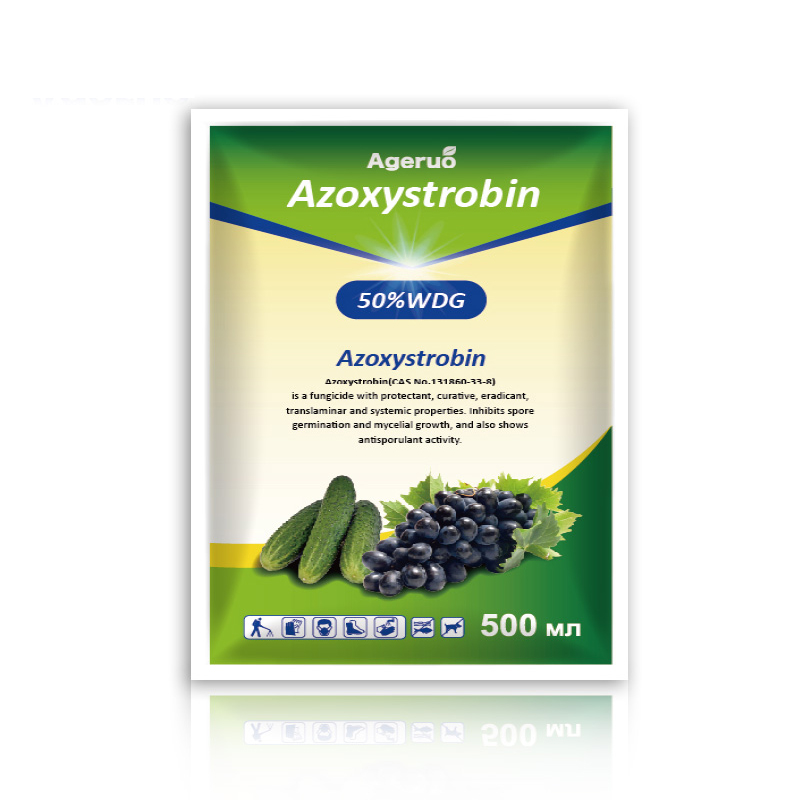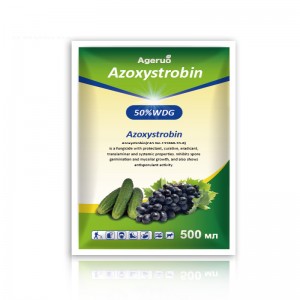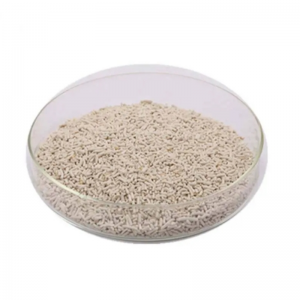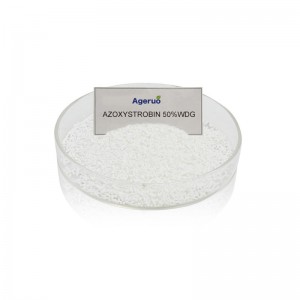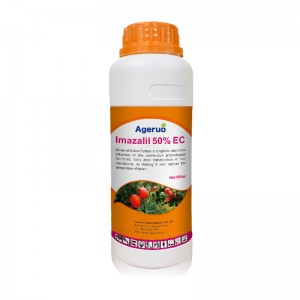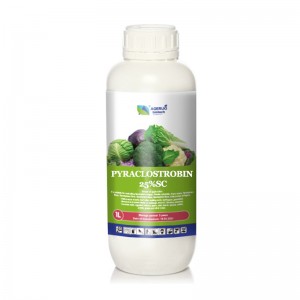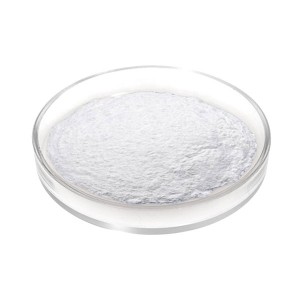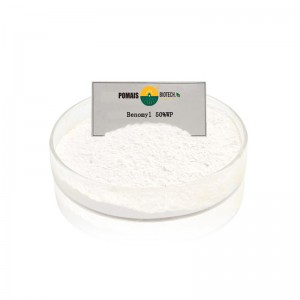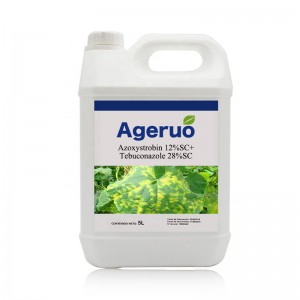Products
POMAIS Fungicide Azoxystrobin 50%WDG | Preventing Potato Blight
Introduction
Azoxystrobin is a trusted, broad-spectrum fungicide in the methoxyacrylate (Strobilurin) class — known worldwide for its powerful systemic and translaminar action.
Unlike many contact-only fungicides, Azoxystrobin 50%WDG moves within the plant tissues, providing inside-out protection that stops fungal spores from germinating, halts mycelial growth, and even works as an antisporulant.
This unique mode of action helps your growers protect crops like potatoes, rice, citrus, cucumbers, and grapes from diseases such as late blight, rice blast, powdery mildew, anthracnose, and rust.
Whether your buyers prefer foliar spray, soil drench, or seed treatment, Azoxystrobin fungicide adapts to different crop systems and local climate conditions — keeping fields cleaner, yields higher, and disease resistance under control.
Plus, with flexible formulations like Azoxystrobin 25%SC, 50%WDG, and smart combinations such as Azoxystrobin + Propiconazole, you can tailor your offer to local resistance profiles and deliver a more complete disease management solution.
Related reading: Azoxystrobin and Propiconazole Fungicide Rotation
| Active Ingredient | Azoxystrobin |
| Name | Azoxystrobin 50%WDG (Water Dispersible Granules) |
| CAS Number | 131860-33-8 |
| Molecular Formula | C22H17N3O5 |
| Application | Can be used for foliar spray, seed treatment and soil treatment of grains, vegetables and crops |
| Brand Name | POMAIS |
| Shelf life | 2 Years |
| Purity | 50%WDG |
| State | Granular |
| Label | Customized |
| Formulations | 25%SC,50%WDG,80%WDG |
| The mixed formulation product | 1.azoxystrobin 32%+hifluzamide8% 11.7% SC
2.azoxystrobin 7%+propiconazol 11.7% 11.7% SC 3.azoxystrobin 30%+boscalid 15% SC 4.azoxystrobin 20%+tebuconazole 30% SC 5.azoxystrobin 20%+metalaxyl-M10% SC |
Package

Mode of Action
What makes Azoxystrobin fungicide stand out from conventional protectants? It’s all about how it works inside the plant — and inside the fungus.
As a methoxyacrylate (Strobilurin) class fungicide, Azoxystrobin 50%WDG targets the fungal mitochondrial respiration process. Specifically, it blocks electron transfer at the Qo site of the cytochrome bc1 complex (Complex III). This disruption shuts down the fungus’s ability to produce energy, which stops spore germination, halts mycelial growth, and ultimately prevents further infection.
Its systemic and translaminar action means it doesn’t just sit on the leaf surface. Once applied, Azoxystrobin penetrates plant tissues and moves upward, delivering long-lasting protection throughout the canopy — including hard-to-reach spots that contact fungicides can miss.
Because of this unique mode of action, Azoxystrobin is highly effective against a wide range of pathogens, but it’s smart to rotate or combine it with other fungicide groups (like Propiconazole) to help manage resistance. Your buyers can confidently position it as a key tool in integrated disease management programs that keep yields stable and input costs predictable.
Suitable Crops:

Act on these Fungal Disease:

Target Crops & Typical Diseases
When you supply Azoxystrobin 50%WDG, you’re giving your buyers a flexible fungicide that works across a wide range of crops and climates — especially where consistent, systemic disease control matters.
Your growers can rely on Azoxystrobin fungicide to prevent and control major fungal threats such as:
-
Potato blight (late blight)
-
Rice blast
-
Downy mildew
-
Powdery mildew
-
Rusts, anthracnose, and leaf spots
Thanks to its translaminar and systemic action, Azoxystrobin moves through plant tissues to protect both new and existing growth, making it ideal for crops with dense canopies or extended harvest periods.
Example Uses & Application Table
| Crop | Key Fungal Diseases | Recommended Rate | Application Method |
|---|---|---|---|
| Potatoes | Late blight | 100–375 g/ha | Foliar spray, pre-outbreak |
| Rice | Rice blast | 100–375 g/ha | Foliar spray |
| Citrus | Anthracnose, scab | 100–375 g/ha | Foliar spray |
| Cucumber | Downy mildew | 100–375 g/ha | Foliar spray |
| Pepper | Blight, leaf spots | 100–375 g/ha | Foliar spray |
| Grapes | Powdery mildew, botrytis | 100–375 g/ha | Foliar spray |
| Seed treatment | Various soil-borne fungi | 200–400 ml/100 kg seed | Seed dressing |
Your buyers can also offer Azoxystrobin + Propiconazole or other smart rotations for resistant disease strains — giving growers added insurance for tough seasons.
By helping your customers match the right rate and method to the right crop, you keep them confident in the results and loyal to your brand.
Recommended Dosage & Application
When you show your buyers how to use Azoxystrobin 50%WDG the right way, you help them deliver consistent protection — and avoid costly mistakes that can lead to resistance or poor results.
Azoxystrobin fungicide works best when applied preventively or at the very first sign of infection. Because it’s systemic and translaminar, it protects both treated leaves and new growth, but good coverage is still key.
Tips for optimal use:
-
Always mix with clean water at the recommended ratio — avoid mixing with ECs (especially organophosphates) or silicone-based adjuvants that can increase phytotoxicity.
-
Use enough spray volume to reach all leaf surfaces, especially in dense canopies like potatoes or grapes.
-
Rotate or tank mix with other fungicide groups, like Azoxystrobin + Propiconazole, to help manage resistance.
Quick Dosage Reference
| Crop | Dosage per Hectare | Spray Timing | Notes |
|---|---|---|---|
| Potatoes | 100–375 g/ha | Pre-outbreak, repeat as needed | For late blight, target early signs |
| Rice | 100–375 g/ha | Early blast stages | Good canopy coverage is critical |
| Cucumbers | 100–375 g/ha | Preventive or early downy mildew | Avoid over-wetting to limit runoff |
| Seed Treatment | 200–400 ml/100 kg seed | Before sowing | Use proper seed treatment equipment |
Clear guidelines mean your buyers spend less time troubleshooting and more time growing customer trust.
Benefits & Grower Value
When your buyers choose Azoxystrobin 50%WDG, they’re giving their growers more than just another fungicide — they’re giving them a tool that saves time, protects yields, and adds real value season after season.
1. Strong Protectant and Curative Action
Thanks to its systemic and translaminar movement, Azoxystrobin fungicide protects both treated surfaces and new growth. Growers see fewer reinfections, less need for rescue sprays, and more stable field conditions even in disease-favorable weather.
2. Wide-Spectrum Control Means Fewer Products Needed
One product tackles multiple fungal diseases — from potato late blight and rice blast to downy mildew and rusts. Your buyers can stock fewer SKUs while giving growers more flexibility.
3. Longer Residual Effect = Lower Labor Cost
Residual activity can last up to 10–14 days depending on the crop and conditions. Fewer applications mean less time in the field, lower fuel costs, and better use of farm labor.
4. Resistance Management Ready
Azoxystrobin 50%WDG fits perfectly into anti-resistance programs when used in rotation or in smart combinations like Azoxystrobin + Propiconazole. This helps protect your buyers’ long-term business by keeping the active ingredient effective for seasons to come.
5. Proven Quality with OEM Flexibility
Your buyers get ISO-certified formulations, reliable QC, and flexible pack sizes — from retail sachets to bulk drums — with multilingual labeling to match local market needs.
When you help your customers show these benefits to growers, you build loyalty that keeps them coming back — field after field, year after year.
Tank Mix Compatibility & Resistance
When your buyers use Azoxystrobin 50%WDG, they’re investing in a fungicide that not only protects crops on its own — but also works well as part of an integrated spray program.
Thanks to its broad-spectrum action and unique Qo site mode of action, Azoxystrobin fungicide is widely recommended for rotation or combination with other fungicide groups to slow resistance development.
Practical mixing tips for your buyers:
-
Always rotate Azoxystrobin with different MOA fungicides — popular choices include Propiconazole, Tebuconazole, or Boscalid — to reduce selection pressure on target fungi.
-
When tank mixing, check local label instructions and do a small jar test to ensure physical compatibility.
-
Avoid mixing Azoxystrobin WDG with EC formulations of organophosphates or silicone adjuvants — excessive penetration can increase phytotoxicity risk.
-
Maintain recommended rates — underdosing speeds up resistance and undermines long-term performance.
Because Azoxystrobin 50%WDG is systemic and translaminar, it delivers strong protection to both leaf surfaces and new shoots — but smart rotation is what keeps its power reliable for seasons to come.
When you provide your buyers with simple, science-backed resistance management guidance, you build trust and help them get the best return from every application.
Safety Measures & Environmental
When your buyers use or distribute Azoxystrobin 50%WDG, helping them follow safe handling and environmental guidelines keeps crops protected and your brand reputation strong.
Azoxystrobin fungicide has a favorable safety profile for operators and non-target organisms when used as directed. It’s systemic, so it penetrates plant tissues instead of staying on the surface, which helps reduce runoff and drift. However, good application practices matter:
Practical safety tips for your buyers:
-
Always wear appropriate PPE — gloves, long sleeves, goggles, and respirators if mixing large tank volumes.
-
Calibrate sprayers properly to avoid overspray and minimize drift, especially near water bodies or pollinator zones.
-
Avoid spraying during windy weather or just before heavy rainfall.
Environmental considerations:
-
Azoxystrobin is considered low risk to most beneficial insects when applied correctly, but buyers should remind growers to avoid spraying during peak bee activity or flowering stages if pollinators are nearby.
-
Store sealed containers in a cool, dry place away from food and feed.
-
Triple-rinse empty packaging and dispose of it according to local agrochemical waste guidelines — never pour leftover mix into drains or water sources.
Because Azoxystrobin systemic and translaminar action reduces the need for frequent repeat sprays, it supports more sustainable farming practices with less overall chemical footprint.
By sharing clear, practical safety and environmental guidance with your buyers, you help them keep growers compliant, build trust in your supply, and maintain long-term relationships.
Field Use Scenarios
When your buyers can share real-world examples of how Azoxystrobin 50%WDG works in the field, they help growers see why it’s worth adding to their spray plan — and why they’ll stick with your brand for the long haul.
Scenario 1: Potato Farm – Late Blight Control
A potato grower notices early signs of late blight during humid weather. They apply Azoxystrobin fungicide preventively at 250 g/ha.
Result: Strong systemic and translaminar protection keeps new leaf growth protected. The grower avoids costly yield losses and reduces the need for rescue sprays later in the season.
Scenario 2: Rice Paddy – Rice Blast Season
A rice farmer uses Azoxystrobin 50%WDG as part of a rotational plan with Propiconazole.
Result: Early blast infections are suppressed, and the systemic action gives added protection during rainy periods — cutting reapplication frequency and saving on labor.
Scenario 3: Greenhouse Cucumbers – Downy Mildew Pressure
A vegetable producer sprays cucumbers preventively with Azoxystrobin before peak downy mildew conditions arrive.
Result: New shoots and undersides of leaves are protected, even in dense canopy areas. The grower reports better fruit quality and more uniform harvests.
Scenario 4: Citrus Orchard – Anthracnose and Rust
In a subtropical orchard, a grower rotates Azoxystrobin 50%WDG with other fungicides to handle anthracnose and rust.
Result: The broad-spectrum control and resistance management help maintain healthy foliage and fruit finish for export standards.
When your buyers can paint a clear picture like this, they make Azoxystrobin systemic fungicide easy to trust — and easy to sell season after season.
FAQ
Q1: Is Azoxystrobin systemic?
Yes — Azoxystrobin 50%WDG has proven systemic and translaminar action, so it protects treated leaves and new growth, giving crops inside-out defense against tough fungal pathogens.
Q2: What crops can Azoxystrobin be used on?
Your buyers can confidently recommend it for potatoes, rice, cucumbers, citrus, grapes, peppers, and more — plus, it works well in greenhouse vegetables and high-value orchard systems.
Q3: Can Azoxystrobin be mixed with other fungicides?
Absolutely. It’s commonly rotated or tank-mixed with Propiconazole, Tebuconazole, or Boscalid to broaden the spectrum and manage resistance. Always follow local label instructions and do a jar test.
Q4: How often should growers spray?
Spray preventively or at first disease signs. Residual activity can last 10–14 days, so reapply according to local conditions and disease pressure for best results.
Q5: Do you offer OEM or private label services?
Yes! We support full OEM/private label — you can get Azoxystrobin fungicide packed in your brand style, with multilingual labels, tailored pack sizes, and all registration support.
Why Choose POMAIS
When you choose POMAIS, you choose more than just a fungicide — you get consistent ISO quality, stable formulations, flexible packaging, and a partner who understands what real field performance means.
Ready to test a free sample, get a bulk quote, or build your own branded line?
Get in touch with our team today — let’s protect your growers’ crops and grow your market together.

